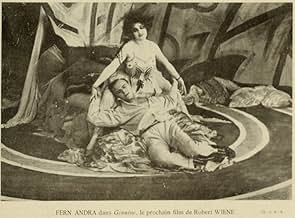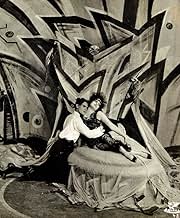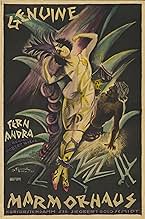Genuine
- 1920
- 1h 28min
VALUTAZIONE IMDb
5,9/10
1218
LA TUA VALUTAZIONE
Genuine è un'antica divinità crudele e sanguinaria, che seduce uomini e li convince a uccidere per lei.Genuine è un'antica divinità crudele e sanguinaria, che seduce uomini e li convince a uccidere per lei.Genuine è un'antica divinità crudele e sanguinaria, che seduce uomini e li convince a uccidere per lei.
Recensioni in evidenza
The same director, cinematographer and writer of "The Cabinet of Dr. Caligari" made this subsequent picture, "Genuine". Likewise, it is also an Expressionist film (one of the few made during Weimar Germany, contrary to what Lotte Eisner and the use by some of "expressionism" as an umbrella term for almost all German cinema of the period might suggest). Additionally, similar to "Caligari", the main body of "Genuine" is framed as a dream. Yet, I wasn't engulfed into the universe of it as I was with "Caligari".
The story, although just as peculiar, isn't as involving, which is unfortunately probably, in part, because the Kino release is only a condensed version. The framing of scenes is just as prosaic and theatrical as that in "Caligari"--if not more so. As well, the stylized acting seems more overdone and obtrusive this time. But, more importantly, the problem is the sets, which I can't see the entire version improving much upon. The Expressionist set designs are equally strange, with odd angels and geometric shapes. The production, however, leaves too much space open and unfilled, which is the largest reason that "Genuine" isn't as involving, or captivating, as "Caligari".
The story, although just as peculiar, isn't as involving, which is unfortunately probably, in part, because the Kino release is only a condensed version. The framing of scenes is just as prosaic and theatrical as that in "Caligari"--if not more so. As well, the stylized acting seems more overdone and obtrusive this time. But, more importantly, the problem is the sets, which I can't see the entire version improving much upon. The Expressionist set designs are equally strange, with odd angels and geometric shapes. The production, however, leaves too much space open and unfilled, which is the largest reason that "Genuine" isn't as involving, or captivating, as "Caligari".
...yes, it's from the same director, Robert Wiene, whose landmark THE CABINET OF DR. CALIGARI was released earlier the very same year, 1920; and, yes, much of the same cinematic technique created for CALIGARI was used here as well. The main differences between the two utterly defeat any chance that GENUINE, at least in the 43-minute "condensation" that appears on the 2002 Kino DVD release, would ever be a tenth as watchable as CALIGARI (or, for that matter, THE HEARTS OF AGE, Orson Welles' self-described "amusement" that spoofed all the surrealist silent European cinema concocted by Wiene, F.W. Murnau, Salvador Dali and the like). First, the sets and makeup of the players are not as flamboyantly odd this time around. Second, the pacing is far too slow for the story. Third, the story is itself far too bizarre and convoluted for a casual viewer to find any interest in; CALIGARI's is relatively straightforward in comparison. If you want a pre-NOSFERATU take on vampires, track down the DVD of LES VAMPIRES instead...
I caught this years back at the Paris Cinematheque hoping to find something of interest from the director of Caligari. It was a disappointment in just about every way for me. First, the film at its original length seemed to go on forever. The elements were there, granted, but they didn't combine as they did in the previous film. I had the feeling of watching a film that was going through all the necessary steps but missing all the points. It was more an exercise in style which blindly followed all the guidelines but missed going anywhere. On the other hand, and perhaps unfairly to subsequent films, "Caligari" was a one-of-a-kinder that left no space for a sequel. Period.
Curtis Stotlar
Curtis Stotlar
I've just viewed the Image DVD of CALIGARI, with commentary by Mike Budd. This DVD also includes excerpts from GENUINE. While the snippets included are pretty strange and disconnected, they show a major similarity between the two films -- that is, the "frame" structure of the story. CALIGARI's frame is that it is a story told by a madman. In GENUINE, it appears that the story is a "dream" experienced by a young man who has fallen asleep reading his favorite novel. What I saw of GENUINE makes it seem the young man's favorite author was Sacher-Masoch. See also how Genuine messes up the young man's hair in a rush of passion -- shades of John Barrymore's transition scenes from DR. JEKYLL AND MR. HYDE?
First off, I am reviewing the "43 minute condensed version" that is found on KINO's "Cabinet of Dr. Caligari," so this is the longest version currently available on video.
It's hard to talk plot line since I have no idea how the somewhat tenuous plot of this version compares to the apparently complete version locked up in Germany, but I can say that the subtitle "A Tale of a Vampire" is erroneous as there is no vampire in this film. The original subtitle is "Tragedy of a Strange House," which is much more accurate to the film in the version I own.
While there is very little to go on story-wise, the set design and imagery is fantastic! While of course, the sets look like painted cardboard (because they are), one must ignore that fact and look at the pure artistry put into the set design. There are some truly disturbing images, such as a skeleton with a clock for a head. And while actual camera movement is absent, this is an early example of a film that allows some action to occur at the fringes of the lens instead of dead center (like you are watching a play). This allows for some interesting and startling entrances from Genuine herself.
Speaking of startling, there is a scene in a slave market that features two women in a gauze-like material. You can see their breasts clearly, one of the earliest examples of nudity in a mainstream film. The nudity isn't highlighted and isn't used for eroticism, but I was surprised to see nipples so clearly in a movie from 1920.
I also must mention the brilliant score. While it is repetitive, it isn't annoying. It seems a perfect fit for such a strange little film. I found the score to be quite complementary to the imagery, and very beautiful as well.
This may not be "Caligari," but it shouldn't be dismissed as it seems to have been by others on this forum. And in its full form--if we ever get to see it--it may just be another "Caligari." Short on plot, but a hallucinogenic, dreamlike, and fascinating trip into a strange world. Try it!
It's hard to talk plot line since I have no idea how the somewhat tenuous plot of this version compares to the apparently complete version locked up in Germany, but I can say that the subtitle "A Tale of a Vampire" is erroneous as there is no vampire in this film. The original subtitle is "Tragedy of a Strange House," which is much more accurate to the film in the version I own.
While there is very little to go on story-wise, the set design and imagery is fantastic! While of course, the sets look like painted cardboard (because they are), one must ignore that fact and look at the pure artistry put into the set design. There are some truly disturbing images, such as a skeleton with a clock for a head. And while actual camera movement is absent, this is an early example of a film that allows some action to occur at the fringes of the lens instead of dead center (like you are watching a play). This allows for some interesting and startling entrances from Genuine herself.
Speaking of startling, there is a scene in a slave market that features two women in a gauze-like material. You can see their breasts clearly, one of the earliest examples of nudity in a mainstream film. The nudity isn't highlighted and isn't used for eroticism, but I was surprised to see nipples so clearly in a movie from 1920.
I also must mention the brilliant score. While it is repetitive, it isn't annoying. It seems a perfect fit for such a strange little film. I found the score to be quite complementary to the imagery, and very beautiful as well.
This may not be "Caligari," but it shouldn't be dismissed as it seems to have been by others on this forum. And in its full form--if we ever get to see it--it may just be another "Caligari." Short on plot, but a hallucinogenic, dreamlike, and fascinating trip into a strange world. Try it!
Lo sapevi?
- QuizA 43-minute condensation of this silent film can be found as an Extra Feature on the Kino Video DVD of Il gabinetto del dottor Caligari (1920). A full-length version is stored at the Munich City Film Museum archive in Germany. A VHS transfer of a full length version (with French intertitles) exists. A copy can be found on YouTube.
- Citazioni
Percy Melo: Dead! She is dead!
- ConnessioniEdited into Histoire(s) du cinéma: Une histoire seule (1989)
I più visti
Accedi per valutare e creare un elenco di titoli salvati per ottenere consigli personalizzati
Dettagli
- Data di uscita
- Paese di origine
- Lingue
- Celebre anche come
- Genuine: The Tragedy of a Vampire
- Luoghi delle riprese
- Azienda produttrice
- Vedi altri crediti dell’azienda su IMDbPro
- Tempo di esecuzione1 ora 28 minuti
- Colore
- Mix di suoni
- Proporzioni
- 1.33 : 1
Contribuisci a questa pagina
Suggerisci una modifica o aggiungi i contenuti mancanti






















